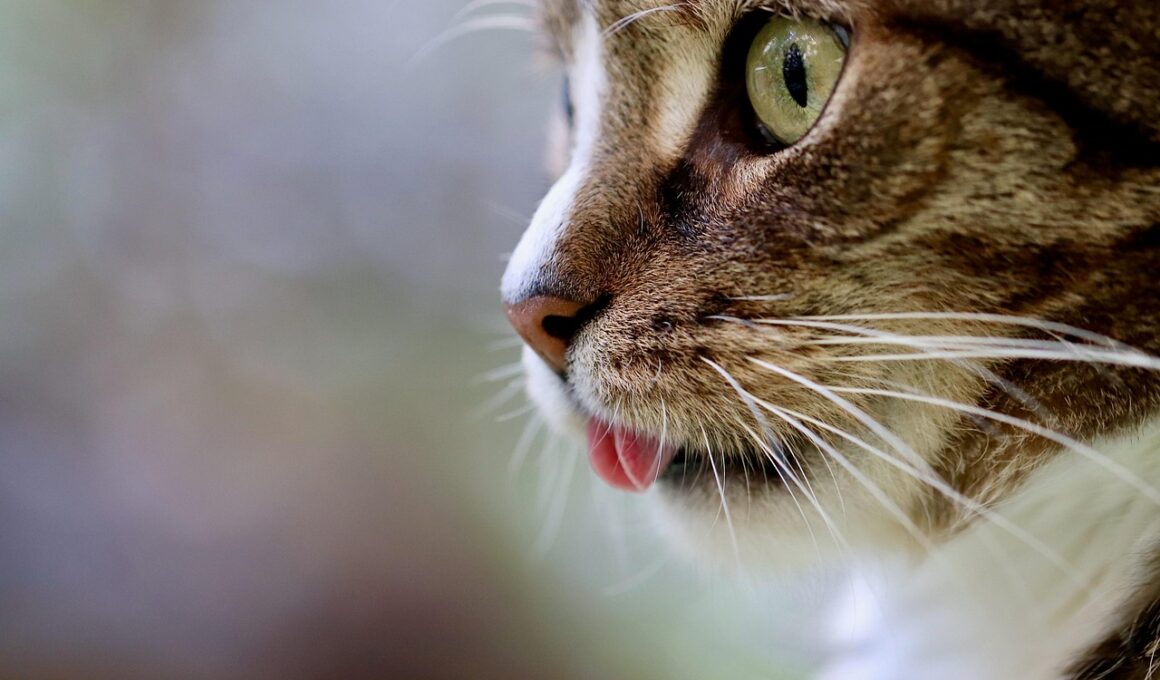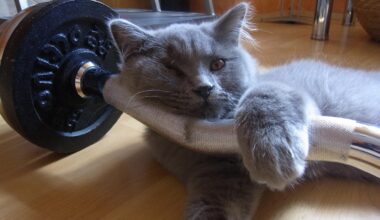Evaluating Vitamin Absorption Differences in Various Cat Breeds
Vitamin absorption varies significantly among different cat breeds, influencing their health and nutrition. While some breeds may excel in utilizing certain vitamins, others might have a predisposition for deficiencies. This inherent variability raises questions concerning the dietary requirements for specific breeds. Understanding these differences can help in developing tailored nutritional plans. A key factor in vitamin absorption involves genetics, which can affect metabolism and gut health. For instance, breeds like the Siamese are known for unique dietary needs. Studies have shown that they may require higher levels of certain vitamins to maintain optimal health. Conversely, larger breeds like the Maine Coon may have different absorption rates due to their body mass. Therefore, it’s crucial for cat owners and breeders to be aware of these distinctions when planning diets. Ensuring adequate vitamin intake is essential, as deficiencies can lead to various health issues. Research in this area continues to evolve, shedding light on the best nutritional practices across different breeds. Understanding these aspects may lead to enhanced well-being and longevity for felines in our care.
Dietary sources of vitamins play a vital role in feline health, yet absorption efficiency can be influenced by a breed’s specific genetics and health status. Furthermore, research shows that certain cats may struggle to metabolize nutrients effectively due to genetic mutations or inherited conditions. For this reason, it is equally essential to evaluate dietary practices among popular breeds, such as the British Shorthair or Burmese. These breeds may exhibit varying responses to similar vitamin levels based on their unique physiological structures. Current nutritional science suggests personalized dietary strategies may optimize vitamin uptake. Specific vitamins, such as A, D, and E, are critical for immunity and healthy body function. Recent advancements in research help to unveil the importance of bioavailability, which illustrates how efficiently vitamins are absorbed into the cat’s bloodstream. Knowing which vitamins are more difficult to absorb allows for better dietary planning and supplementation as needed. Additionally, veterinarian consultations can gauge proper nutritional needs tailored to individual cat breeds. Enhanced nutrient absorption strategies can lead to improved health outcomes, vitality, and potentially longer life spans in our feline companions.
The Impact of Breed on Vitamin Absorption
Studies indicate that not only genetics but also the breed characteristics can significantly influence vitamin absorption in cats. Some breeds are predisposed to certain deficiencies. For instance, the Oriental Shorthair may struggle with vitamin D absorption, which is crucial for bone health. In comparison, the Persian breed shows greater efficiency in utilizing vitamin A, a vital nutrient for vision and overall health. Additionally, differences in digestive physiology, including stomach pH levels, can impact how effectively a cat can absorb vitamins from their diet. This is particularly relevant for older cats who may experience decreased digestive efficiency. Furthermore, hydration levels and dietary factors can additionally modify absorption rates. High-fiber diets, while beneficial for many cats, can inhibit the absorption of certain fat-soluble vitamins. Adapting the diet to keep breed-specific health considerations in mind allows cat owners to provide more comprehensive care. Careful analysis of nutritional needs is necessary to ensure that all breeds receive balanced diets. Consequently, continuous research on these variances will pave the way for more informed dietary strategies benefiting cats of all breeds in the future.
Incorporating supplements may aid in vitamin absorption for specific breeds. However, before adding any supplements, it is critical to consult with a veterinarian to determine the individual needs of your cat. Some breeds may naturally require additional help due to metabolic differences. For example, the Ragdoll breed, known for its size and gentle temperament, might benefit from added vitamins during critical growth phases. Furthermore, the lifestyles of indoor versus outdoor cats can affect nutrient absorption; for instance, outdoor cats often have more diverse diets due to hunting. Just as diet strategies differ, supplementation must be tailored to individual needs. Developed nutritional supplements could offer a more balanced intake of vitamins essential for each breed. In addition, recent findings suggest that the timing of vitamin intake can influence absorption. For some nutrients, ensuring they are provided with a meal can increase the likelihood of absorption. Therefore, developing a vitamin strategy tailored to your cat’s breed and lifestyle can promote optimal health. By remaining proactive in this regard, pet owners can significantly contribute to their cat’s overall well-being and agility.
Common Vitamins and Their Benefits
Several essential vitamins play prominent roles in feline health and can affect absorption rates among various breeds. Vitamin A, vital for skin health and vision, proves especially crucial for kittens as they develop. Additionally, B vitamins support metabolism and energy levels, while Vitamin E functions as an antioxidant, protecting cells from oxidative damage. By understanding which vitamins have higher absorption rates among particular breeds, pet owners can devise better diets and supplement plans. For example, improving the intake of Vitamin B12 is essential for certain breeds prone to absorption issues, which can lead to lethargy and weight loss. Expert recommendations suggest focusing on complete and balanced cat food that covers basic vitamin requirements. Maintaining diversity in pet diets contributes to overall health and enhances the quality of nutrient absorption. This information is invaluable for cat owners dedicated to optimizing nutrition for their feline friends. Ensuring that any supplements administered are tailored to a cat’s specific breed enhances their application and effectiveness. Tailoring vitamin intake to specific feline needs can vastly improve the overall health and vitality of our cats.
Emerging research may lead us to rethink common perceptions about vitamins and their absorption across cat breeds. For instance, muscle mass and physical activity levels can also influence nutritional needs. Active breeds, like the Bengal, might require more vitamins to sustain energy and support muscle recovery, emphasizing the need for understanding breed metabolism. Even hydration plays a crucial role in how vitamins are utilized in the body. The interaction between water intake and vitamin potency reveals complex metabolic pathways. Hence, identifying a cat’s hydration levels can assist veterinarians in determining dietary recommendations. Furthermore, the role of gut microbiota in vitamin absorption has gained attention, as diverse gut flora can enhance nutrient uptake. In this regard, the importance of probiotics cannot be ignored, as these may support optimal digestion and absorption of essential vitamins. Addressing these factors improves our understanding of feline dietary needs. By focusing on breed-specific factors, nutritional guidance can be refined, leading to better health outcomes. Therefore, continuous research is necessary to further unravel the complexities of cat nutrition.
Future Directions in Cat Vitamin Research
As we look to the future, the exploration of vitamin absorption differences among cat breeds is crucial. Current research is underway to evaluate the genetic aspects influencing nutrient metabolism, bringing greater insight into dietary needs. Potential studies focus on broader genetic testing among breeds to discover hereditary traits impacting absorption. This increased knowledge can facilitate a shift towards personalized nutrition plans that cater to individual feline needs. Additionally, researchers are investigating the environmental factors affecting vitamin absorption rates, which might open new avenues for nutrition strategies. By understanding these dynamics, veterinary professionals can offer precise dietary recommendations for various cat breeds. Collaboration between pet food companies and clinical researchers will be essential to innovate solutions and advancements in feline nutrition. Furthermore, educating cat owners about essential vitamins and potential absorption challenges will enhance the owner’s role in optimizing their pet’s health. Ultimately, tailored and research-based dietary strategies can pave the way for healthier, longer lives for domestic cats. Feeding our cats appropriately plays a significant role in ensuring their quality of life.
In conclusion, comprehending the differences in vitamin absorption across cat breeds is paramount for every cat owner. Tailoring diets to meet breed-specific needs can foster enhanced overall health and vitality. By acknowledging variations in genetic backgrounds, metabolism, and nutritional requirements, we can significantly improve our feline friends’ diets. While research is ongoing, the advancements made thus far provide a stronger foundation for understanding the intricate relationship between nutrients and feline health. A focus on personalized dietary plans that consider various breed influences can lead to more prolonged, healthier lives for cats. Providing a balanced diet rich in the essential vitamins mentioned will aid in promoting optimal health. Moreover, fostering open dialogue with veterinarians and nutritionists can help adapt feeding strategies specifically tailored to each cat’s unique needs. Each breed may require different approaches, and the pet owner’s involvement is essential in supporting their feline friend’s nutrition journey. As we continue to understand more, we will strengthen our commitment to responsible and informed pet ownership, ensuring the highest quality of life for our cats. Sustainable and health-focused choices will ultimately result in our beloved companions thriving in our care.


